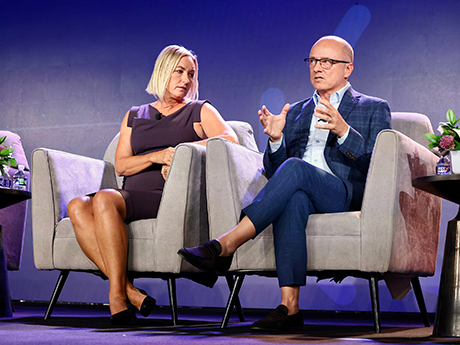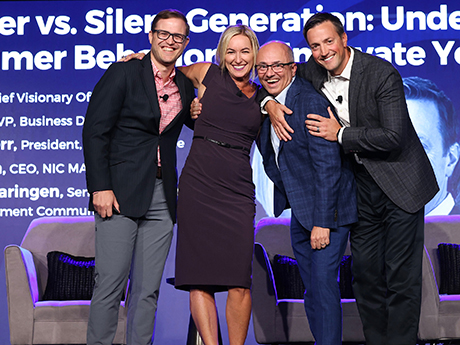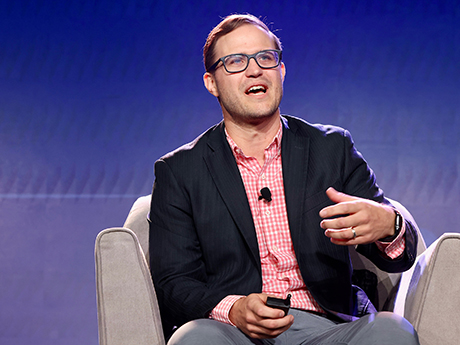WASHINGTON, D.C. — The seniors housing industry needs to improve overall customer service to deliver a more engaging and enriching product, according to William Swearingen, senior vice president of Spectrum Retirement Communities, a Denver-based owner and operator that offers independent living, assisted living and memory care.
The good news is there are no barriers to entry to fix the problem.
“It doesn’t take a budget; we don’t have to have the massive cash flow right out of the gate to be able to make these changes in the buyer experience,” said Swearingen. As of June 1, Spectrum owned 5,424 units across 36 communities and operated 42 communities housing 6,151 units, according to the American Seniors Housing Association.
The comments from Swearingen came during a panel discussion at the 2022 NIC Fall Conference held recently at the Marriott Marquis in downtown Washington, D.C. The panel — moderated by Joe Daniels, vice president of business development at Direct Supply — was titled “Boomer Versus Silent Generation: Understanding Consumer Behaviors to Innovate Your Product,” and included panelists Arick Morton, chief executive officer at NIC MAP Vision; and Traci Bild, chief visionary officer at Bild & Co; in addition to Swearingen.
Other related topics of discussion included understanding residents, their generational differences and how to tailor senior living communities to residents’ needs and desires.
Not your parents’ consumer behavior
Improved customer service begins with developing a better understanding of the wants and needs of current and prospective residents and recognizing that a generational shift is afoot.
When asked by an audience member, one of approximately 2,800 industry professionals in attendance at the conference, to define the distinction between baby boomers and the Silent Generation, Morton spoke to the lived experience of each generation.
“[The Silent Generation] grew up in the Depression, maybe lived through the war…. The boomers had a lot more agency in their lives. The economy and the world became a much more on-demand world, and a world that adapted to you, as opposed to you adapted to the world,” said Morton.
Generational differences between boomers (persons born between 1946 and 1964) and the preceding Silent Generation (individuals born between 1928 and 1945) was the predominant topic. Panelists noted that, as consumers, the Silent Generation lives up to its moniker in a literal way. Relative to boomers, they are less apt to voice desires and concerns, the panel pointed out.
“The Silent Generation is very accommodating, they’re very respectful, they’re not going to complain,” said Bild. “The boomers are going to like to stomp their feet, stick their lips out and pout. They’re not just going to accept what we give them.”
Another mark of the boomer individual, according to the panel, is a focus on value. This means that aging boomers will need to see and believe in the value of a community, or they will prefer staying home, but it also presents an opportunity, according to Bild: “They’re going to be willing to go further than their parents did to get the experience and the lifestyle they want, which is kind of exciting, because it gives people a further reach to fill their buildings faster.”
Another demographic reality to contend with is that of the adult children who will be involved in, or even responsible for, the care of their boomer parents, the panel pointed out. It is essential not only to cater to the preferences of current and future residents, but also be aware of “where that sales decision is driven or influenced or made by that adult child,” noted Morton. “The adult child is no longer going to be a boomer. It’s going to be a Millennial or a Gen-Xer, and that’s a completely different buyer persona as well.”

Traci Bild (left), chief visionary officer of Bild & Co. and William Swearingen, senior vice president of marketing and sales at Spectrum Retirement Communities LLC.
Know your residents
Even as it offered analysis of the generations and their differences, the panel cautioned against falling into the trap of accepting stereotypes, making assumptions or projecting expectations onto the consumer.
For one, the generations are not homogenous. Both the boomer and Silent generations comprise populations of 60 million and 40 million respectively, and “there is incredible heterogeneity across almost every point of life possible,” said Morton.
So how can communities figure out the consumer and what they want? Ask them, said the panel.
“I would just ask the customers. I think we have to get back to asking people what they want instead of us trying to figure it out for them,” said Bild. “They’re more than happy to tell you, and also [it’s ideal] when you involve someone in that discovery process — not just through some survey you mail out, but sitting down and asking them.”
“Even if you have an old, dated building,” you can make prospective residents “feel heard, seen, wanted, valued,” said Bild. “If you have a staff that’s trained with that level of emotional intelligence, I just think that is going to help attract more boomers.”
Bingo isn’t the answer
Use the knowledge gleaned from getting to know current and prospective residents to tailor programming that is engaging. “The reality is, no one living in your community played bingo before they moved in,” remarked Swearingen.
For the ubiquitous bingo’s replacement, panelists suggested looking to the ages of residents and the programming in the surrounding community.
According to a study on aging conducted by Stanford and cited by Swearingen, identity and taste are defined and fairly fixed by the age of 40.
“There is nothing that is sitting on a calendar right now in any senior living community that is connected to when these people were in their 40s. That was the late ’70s and the early ’80s,” says Swearingen. “Look at programming in your community. There are ways to do this to where you can open up your market share.”
More diversity outreach efforts needed
Age was not the only demographic feature discussed during the panel. On the topic of diversity — or lack thereof — among residents, panelists agreed that senior living communities have work to do. Concurring with Swearingen’s assessment that residents are predominantly white, Bild stated that “when you walk in the building, it’s the same demographic.”
Swearingen believes that the pursuit of a more diverse resident population will lead to more senior living community move-ins. “These are populations that are growing. These are populations that have economic power,” he said.
However, such a pursuit necessitates education and innovation on the part of the senior living operators, both in marketing to and accommodating these populations. “Understand what they’re looking for in a senior living community,” said Swearingen. “Create opportunities for representation that lives outside of a caregiving role.”
Bild weighed in on this issue, pointing out that different communities “have their own wants, needs, desires and cultural views.”
Bild also added that the education should be a two-way street between operators and prospective residents. In addition to operators learning about the minority populations they are now targeting — as well as their wants and needs — operators are also “educating them on the benefits and getting them to come in to experience the community itself so that we can build that trust.”
No growth without discomfort
Audience members were left with two major takeaways on change in the senior living housing industry: it is both difficult and necessary.
Daniels of Direct Supply put it bluntly: “Change is hard; creating [change] is very, very difficult.”
Bild agreed, adding that it’s “easier just to keep doing the same thing. It takes more effort to step out of your comfort zone.”
Still, the panel urged housing and care providers to get out of their own way and make the effort to evolve and create quality communities for a wider population. As Swearingen put it: “Everybody ages, and everybody deserves what we provide.”
—Hayden Spiess


